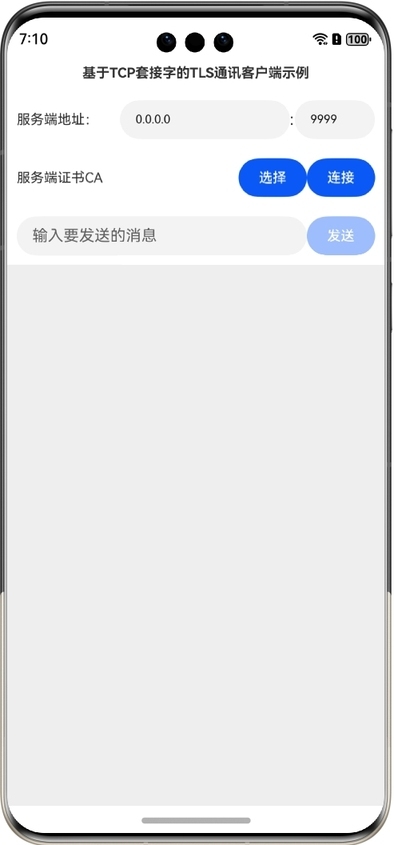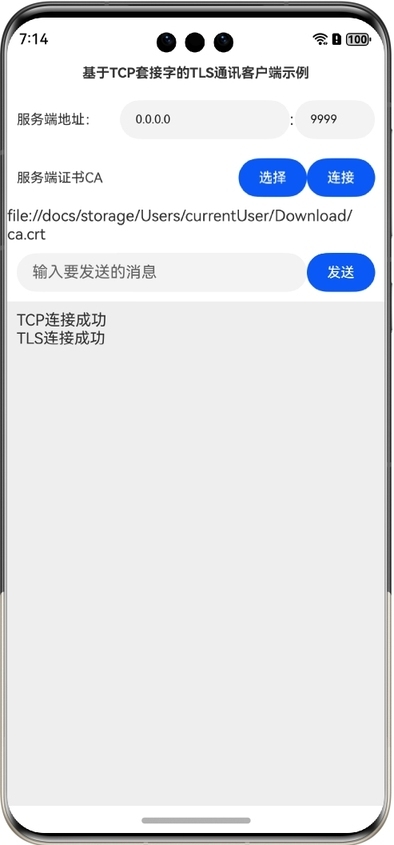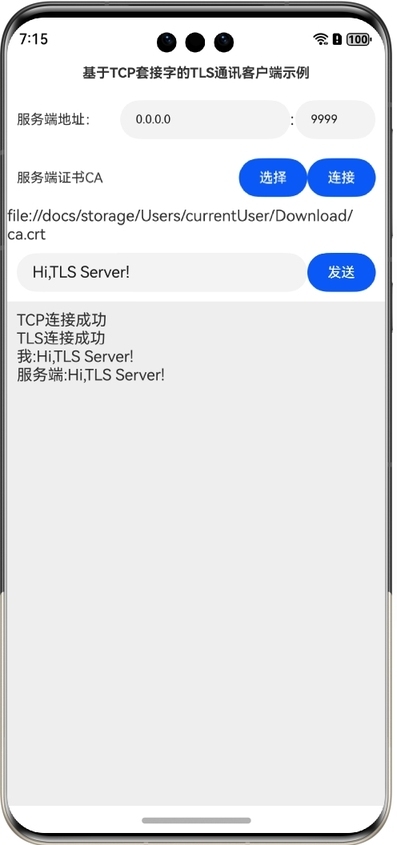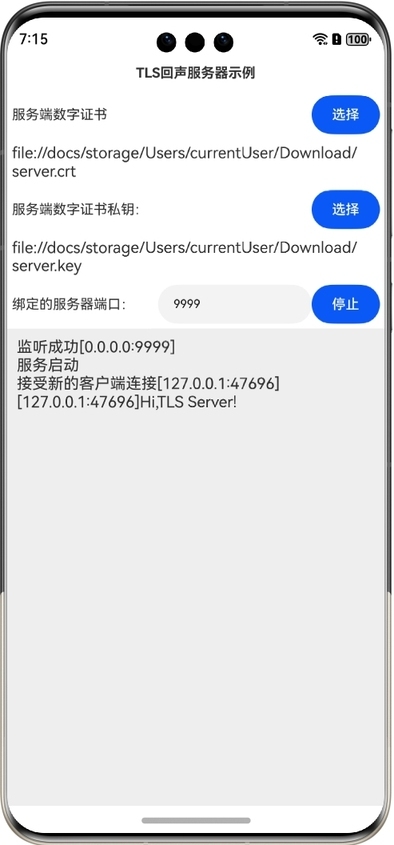1. TLS 通讯简介
在本系列的第 7、8 篇文章,分别讲解了基于 TLS 传输单向和双向认证的通讯示例,这两个示例都是 TLS 客户端直接连接 TLS 服务端的。众所周知,TLS 通讯也是基于 TCP 协议的,首先在 TCP 协议上,客户端和服务端连接成功,然后双方经过 TLS 握手过程,认证数字证书,最后再进行加密的通讯。既然这样,能不能先显式建立 TCP 连接,然后把这个连接再升级为 TLS 协议呢?在鸿蒙的早期版本是不可以的,不过在 API 12 提供了一个新的函数:
function constructTLSSocketInstance(tcpSocket: TCPSocket): TLSSocket;
复制代码
通过该函数,可以基于一个已经建立连接的 TCP 套接字生成 TLS 客户端,然后不经过调用 bind 函数,就可以和服务端建立连接。
本文将通过一个示例演示上述过程,也就是首先建立一个 TCP 客户端,然后该客户端通过 TCP 协议和 TLS 服务端建立连接,然后再基于该 TCP 客户端创建 TLS 客户端,在配置好服务端 CA 证书后,再和 TLS 服务端建立连接,最后进行正常的 TLS 通讯,本示例可以使用在本系列第 33 篇文章《鸿蒙网络编程系列 33-TLS 回声服务器示例》中创建的 TLS 服务端,并且需要预先启动服务端。
2. 基于 TCP 套接字的 TLS 客户端演示
本示例运行后的界面如图所示:
输入服务端地址和端口,,然后单击“选择”按钮选择服务端证书的 CA 证书,最后单击“连接”按钮即可连接 TLS 服务端,如图所示:
通过日志区域可以看到,首先建立了 TCP 连接,然后再建立了 TLS 连接。连接成功后,输入要发送的消息,再单击“发送”按钮即可发送消息给服务端,如图所示:
此时查看服务端,也可以看到客户端发送的消息,如图所示:
3. 基于 TCP 套接字的 TLS 客户端示例编写
下面详细介绍创建该示例的步骤。
步骤 1:创建 Empty Ability 项目。
步骤 2:在 module.json5 配置文件加上对权限的声明:
"requestPermissions": [ { "name": "ohos.permission.INTERNET" } ]
复制代码
这里添加了访问互联网的权限。
步骤 3:在 Index.ets 文件里添加如下的代码:
import socket from '@ohos.net.socket';import { BusinessError } from '@kit.BasicServicesKit';import fs from '@ohos.file.fs';import { picker } from '@kit.CoreFileKit';import { util } from '@kit.ArkTS';
@Entry@Componentstruct Index { @State title: string = '基于TCP套接字的TLS通讯客户端示例'; //连接、通讯历史记录 @State msgHistory: string = '' //要发送的信息 @State sendMsg: string = '' //服务端IP地址 @State serverIp: string = "0.0.0.0" //服务端端口 @State serverPort: number = 9999 //是否可以发送消息 @State canSend: boolean = false //选择的ca文件 @State caFileUri: string = '' tlsSocket: socket.TLSSocket | undefined scroller: Scroller = new Scroller()
build() { Row() { Column() { Text(this.title) .fontSize(14) .fontWeight(FontWeight.Bold) .width('100%') .textAlign(TextAlign.Center) .padding(10)
Flex({ justifyContent: FlexAlign.Start, alignItems: ItemAlign.Center }) { Text("服务端地址:") .fontSize(14) .width(90) .flexGrow(1)
TextInput({ text: this.serverIp }) .onChange((value) => { this.serverIp = value }) .width(110) .fontSize(12) .flexGrow(4)
Text(":") .width(5) .flexGrow(0)
TextInput({ text: this.serverPort.toString() }) .type(InputType.Number) .onChange((value) => { this.serverPort = parseInt(value) }) .fontSize(12) .flexGrow(2) .width(50) } .width('100%') .padding(10)
Flex({ justifyContent: FlexAlign.Start, alignItems: ItemAlign.Center }) { Text("服务端证书CA") .fontSize(14) .width(90) .flexGrow(1)
Button("选择") .onClick(async () => { this.caFileUri = await selectSingleDocFile(getContext(this)) }) .width(70) .fontSize(14)
Button("连接") .onClick(() => { this.connect2Server() }) .width(70) .fontSize(14) } .width('100%') .padding(10)
Text(this.caFileUri) .width('100%')
Flex({ justifyContent: FlexAlign.Start, alignItems: ItemAlign.Center }) { TextInput({ placeholder: "输入要发送的消息" }).onChange((value) => { this.sendMsg = value }) .width(200) .flexGrow(1)
Button("发送") .enabled(this.canSend) .width(70) .fontSize(14) .flexGrow(0) .onClick(() => { this.sendMsg2Server() }) } .width('100%') .padding(10)
Scroll(this.scroller) { Text(this.msgHistory) .textAlign(TextAlign.Start) .padding(10) .width('100%') .backgroundColor(0xeeeeee) } .align(Alignment.Top) .backgroundColor(0xeeeeee) .height(300) .flexGrow(1) .scrollable(ScrollDirection.Vertical) .scrollBar(BarState.On) .scrollBarWidth(20) } .width('100%') .justifyContent(FlexAlign.Start) .height('100%') } .height('100%') }
//发送消息到服务端 sendMsg2Server() { this.tlsSocket?.send(this.sendMsg + "\r\n") .then(async () => { this.msgHistory += "我:" + this.sendMsg + "\r\n" }) .catch((err: BusinessError) => { this.msgHistory += `发送失败:错误码 ${err.code}, 错误信息 ${JSON.stringify(err)}\r\n`; }) }
//连接服务端 async connect2Server() { //服务端地址 let serverAddress: socket.NetAddress = { address: this.serverIp, port: this.serverPort, family: 1 }
let tcpSocket = socket.constructTCPSocketInstance() await tcpSocket.connect({ address: serverAddress }) .then(async () => { this.msgHistory += 'TCP连接成功 ' + "\r\n"; }) .catch((err: BusinessError) => { this.msgHistory += `TCP连接失败:错误码 ${err.code}, 错误信息 ${JSON.stringify(err)}\r\n`; return })
//执行TLS通讯的对象 this.tlsSocket = socket.constructTLSSocketInstance(tcpSocket)
this.tlsSocket.on("message", async (value) => { let msg = buf2String(value.message) this.msgHistory += "服务端:" + msg + "\r\n" this.scroller.scrollEdge(Edge.Bottom) })
let context = getContext(this)
let opt: socket.TLSSecureOptions = { ca: [copy2SandboxAndReadContent(context, this.caFileUri)] }
await this.tlsSocket.connect({ address: serverAddress, secureOptions: opt }) .then(async () => { this.msgHistory += 'TLS连接成功 ' + "\r\n"; this.canSend = true }) .catch((err: BusinessError) => { this.msgHistory += `TLS连接失败:错误码 ${err.code}, 错误信息 ${JSON.stringify(err)}\r\n`; }) }}
//选择一个文件async function selectSingleDocFile(context: Context): Promise<string> { let selectedFilePath: string = "" let documentPicker = new picker.DocumentViewPicker(context); await documentPicker.select({ maxSelectNumber: 1 }).then((result) => { if (result.length > 0) { selectedFilePath = result[0] } }) return selectedFilePath}
//复制文件到沙箱并读取文件内容function copy2SandboxAndReadContent(context: Context, filePath: string): string { let segments = filePath.split('/') let fileName = segments[segments.length-1] let realUri = context.cacheDir + "/" + fileName let file = fs.openSync(filePath); fs.copyFileSync(file.fd, realUri) fs.closeSync(file)
return fs.readTextSync(realUri)}
//ArrayBuffer转utf8字符串function buf2String(buf: ArrayBuffer) { let msgArray = new Uint8Array(buf); let textDecoder = util.TextDecoder.create("utf-8"); return textDecoder.decodeToString(msgArray)}
复制代码
步骤 4:编译运行,可以使用模拟器或者真机。
步骤 5:按照本节第 2 部分“基于 TCP 套接字的 TLS 客户端演示”操作即可。
4. 代码分析
本示例关键点在于创建 TLS 客户端的过程,首先要创建 TCP 客户端并且连接成功,其次才能创建 TLS 客户端::
//服务端地址 let serverAddress: socket.NetAddress = { address: this.serverIp, port: this.serverPort, family: 1 }
let tcpSocket = socket.constructTCPSocketInstance() await tcpSocket.connect({ address: serverAddress }) .then(async () => { this.msgHistory += 'TCP连接成功 ' + "\r\n"; }) .catch((err: BusinessError) => { this.msgHistory += `TCP连接失败:错误码 ${err.code}, 错误信息 ${JSON.stringify(err)}\r\n`; return })
//执行TLS通讯的对象 this.tlsSocket = socket.constructTLSSocketInstance(tcpSocket)
复制代码
另外一点是关于配置 TLS 客户端的服务端 CA 证书,选择证书后需要复制到沙箱才能读取文件内容,这一点是通过函数 copy2SandboxAndReadContent 实现的。
(本文作者原创,除非明确授权禁止转载)
本文源码地址:
https://gitee.com/zl3624/harmonyos_network_samples/tree/master/code/tls/TCPBaseTLSClient
本系列源码地址:
https://gitee.com/zl3624/harmonyos_network_samples














评论